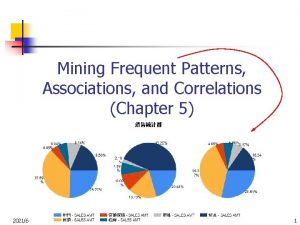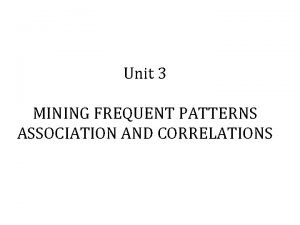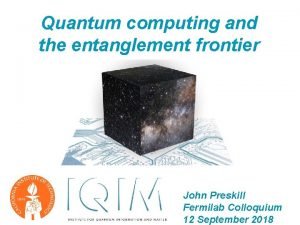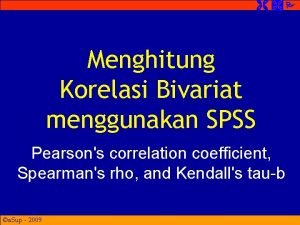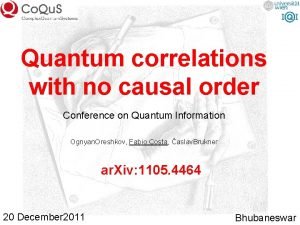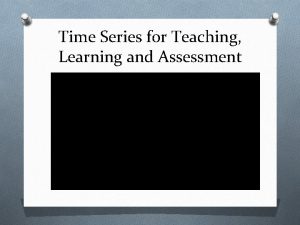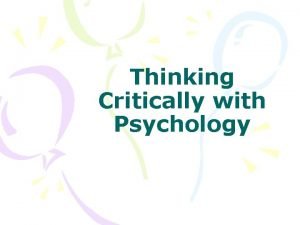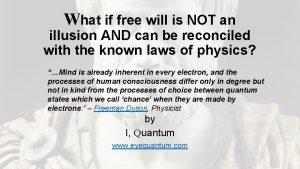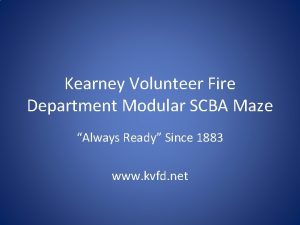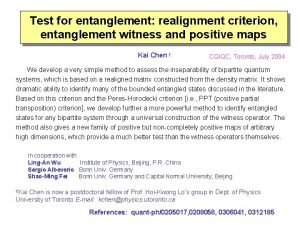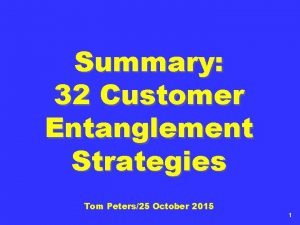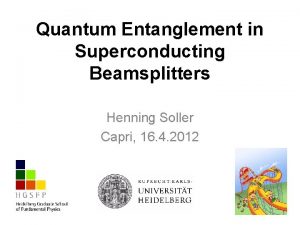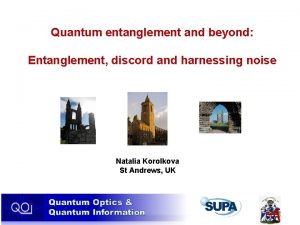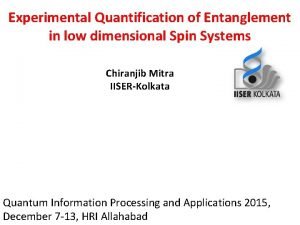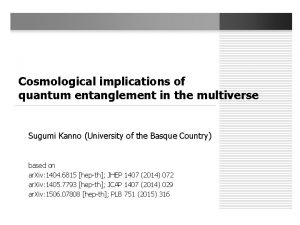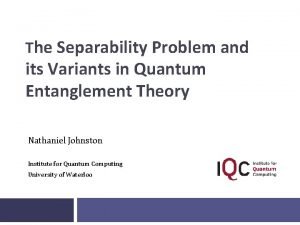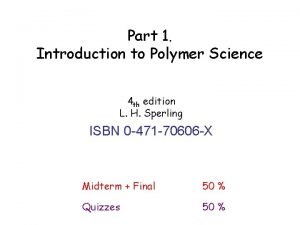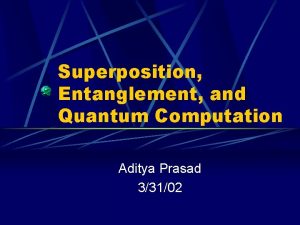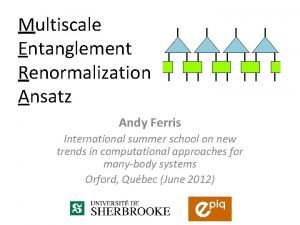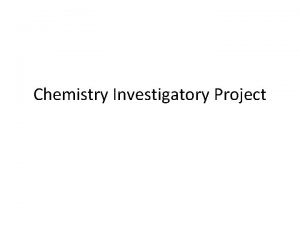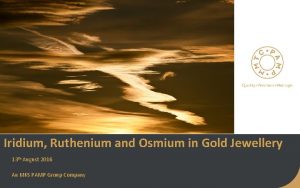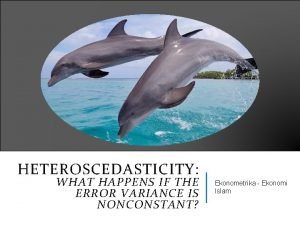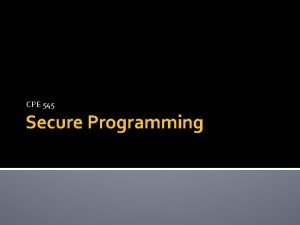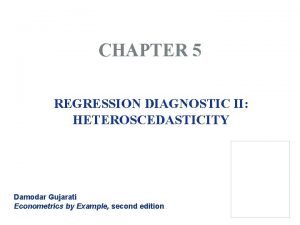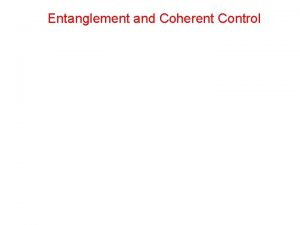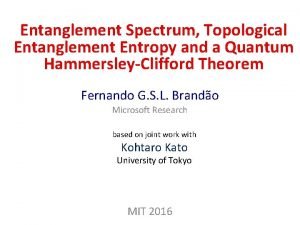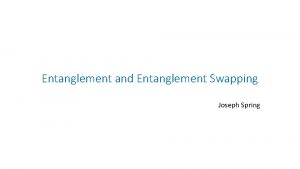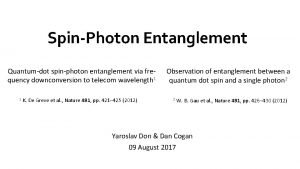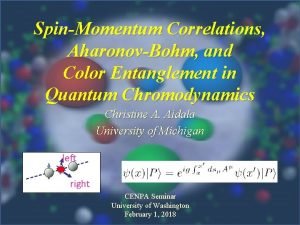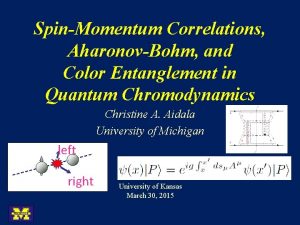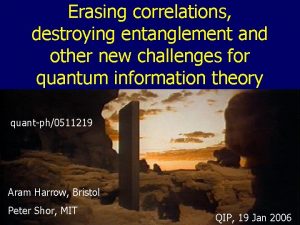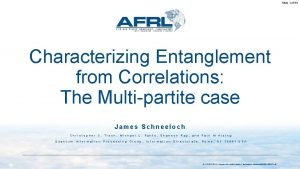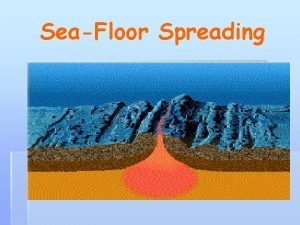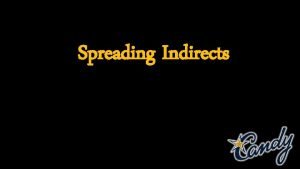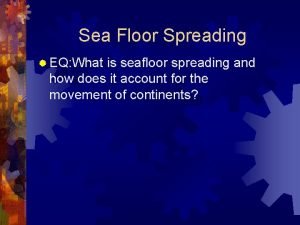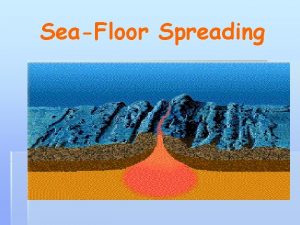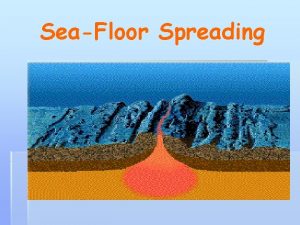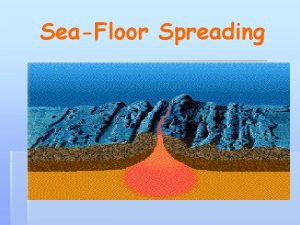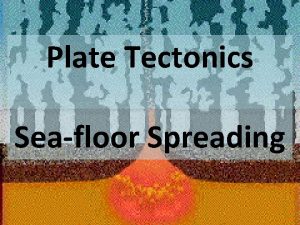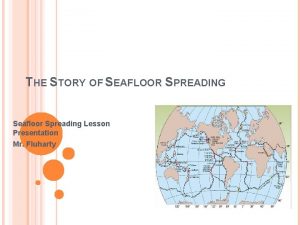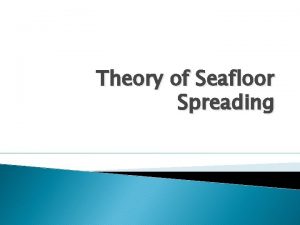Using timetime correlations to detect entanglement and spreading









![Experimental results [MG, J. G. Bohnet et al. Nat. Phys. 13 781 (2017)] Martin Experimental results [MG, J. G. Bohnet et al. Nat. Phys. 13 781 (2017)] Martin](https://slidetodoc.com/presentation_image_h/26603054acbe93c75f4aba53dd0f05ba/image-10.jpg)
















- Slides: 26

Using time-time correlations to detect entanglement and spreading of quantum information Martin Gärttner Kirchhoff-Institut für Physik, Heidelberg QSEC 2019 Heidelberg September 26, 2019 Martin Gärttner - QSEC 2019 1

(Analog) Quantum simulation evolve measure Goal: Characterize the prepared states as a function of t and the parameters of H. Problem: • Often only global measurements possible • Full state tomography not feasible for large N Martin Gärttner - QSEC 2019 2

Quantum simulation extended easy to prepare separable interesting entangled? useful? perturb time reversal measure → Measure time-time correlations, out-of-time-order correlations → extract more information about → only global observables needed Martin Gärttner - QSEC 2019 3

OTOCs quantify operator growth Martin Gärttner - QSEC 2019 4

Operator growth Example: site i site j t=0 t>0 operators grow in in time, quantified by commutator Martin Gärttner - QSEC 2019 “scrambling” 5

OTOC measurement in spin systems prepare evolve rotate evolve back measure time Martin Gärttner - QSEC 2019 6

Collective operator spreading At least m terms Martin Gärttner - QSEC 2019 7

Penning trap quantum simulator Martin Gärttner - QSEC 2019 8

With Justin Bohnet Group of John Bollinger (NIST Boulder) Penning trap experiment ODF Britton et al. Nature 2012 Bohnet et al. Science 2015 Two hyperfine states used as spin ½ system CM at Martin Gärttner - QSEC 2019 9
![Experimental results MG J G Bohnet et al Nat Phys 13 781 2017 Martin Experimental results [MG, J. G. Bohnet et al. Nat. Phys. 13 781 (2017)] Martin](https://slidetodoc.com/presentation_image_h/26603054acbe93c75f4aba53dd0f05ba/image-10.jpg)
Experimental results [MG, J. G. Bohnet et al. Nat. Phys. 13 781 (2017)] Martin Gärttner - QSEC 2019 10

Fourier transform of magnetization [MG, J. G. Bohnet et al. Nat. Phys. 13 781 (2017)] • Observe operator spreading • Only global spin measurement Martin Gärttner - QSEC 2019 11

OTOCs quantify coherence Martin Gärttner - QSEC 2019 12

Multiple quantum coherences Example: N=3 0 m=-1 m=-2 -3 1 m=0 m=-1 -2 2 m=1 m=0 -1 3 m=2 m=1 0 Martin Gärttner - QSEC 2019 [NMR: Pines group 1980 s] 13

Multiple quantum coherences prepare evolve rotate evolve back measure time Martin Gärttner - QSEC 2019 14

MQC – experimental results N=48 Lines: Simulation including decoherence [MG, J. G. Bohnet et al. Nat. Phys. 13 781 (2017)] Martin Gärttner - QSEC 2019 15

OTOCs detect entanglement Martin Gärttner - QSEC 2019 16

OTOCs as lower bound on QFI → OTOC witnesses multi-particle entanglement. [MG, P. Hauke, A. M. Rey, Phys. Rev. Lett. 120, 040402 (2018)] Martin Gärttner - QSEC 2019 17

OTOCs detect chaos Martin Gärttner - QSEC 2019 18

OTOCs for quantum chaos Quantum – classical correspondence Truncated Wigner Lyapunov exponent Ion experiment: Two bosonic modes class. integrable no chaos Minimal model showing chaos? Three-mode system with integrability breaking? Martin Gärttner - QSEC 2019 19

Three-mode system Martin Gärttner - QSEC 2019 20

Three-mode chaos 1 M. Rautenberg and MG, ar. Xiv: 1907. 04094 0 Martin Gärttner - QSEC 2019 21

Time reversal in spinor BECs Rb BEC Spin-changing collisions: Martin Gärttner - QSEC 2019 M. Rautenberg and MG, ar. Xiv: 1907. 04094 22

Exponential OTOC growth Using truncated Wigner simulations PRELIMINARY Exact diagonalization only up to N=100 Martin Gärttner - QSEC 2019 23

OTOCs in (Rydberg) spin systems Hamiltonian engineering time Time reversal: pulse sequence 1 → H pulse sequence 2 → -H Martin Gärttner - QSEC 2019 24

Acknowledgements A. M. Rey M. Wall J. Bollinger J. Bohnet A. Safavi-Naini R. Lewis-Swan K. Gilmore Martin Gärttner - QSEC 2019 P. Hauke 25

The Team Stefanie Czischek Linda Shen Michael Rautenberg Jan Philipp Klinger Marcel Neugebauer Sebastian Syrkowski Adrian Breamer Thank you! Martin Gärttner - QSEC 2019 26
 Associations and correlations in data mining
Associations and correlations in data mining Associations and correlations in data mining
Associations and correlations in data mining Mining frequent patterns associations and correlations
Mining frequent patterns associations and correlations Quantum computing
Quantum computing Korelasi pearson spss
Korelasi pearson spss Quantum correlations with no causal order
Quantum correlations with no causal order Spurious correlations
Spurious correlations Illusory correlations ______.
Illusory correlations ______. What is time
What is time Firefighter maze plans
Firefighter maze plans Entanglement witness
Entanglement witness Entanglement strategy
Entanglement strategy Henning soller
Henning soller Entanglement
Entanglement Discord
Discord Chiranjib mitra
Chiranjib mitra 3002001030
3002001030 Quantum entanglement
Quantum entanglement Polymer entanglement
Polymer entanglement Entanglement vs superposition
Entanglement vs superposition Tranformation
Tranformation Index for chemistry project
Index for chemistry project Detect golden ticket attack
Detect golden ticket attack How to detect iridium in gold
How to detect iridium in gold How to detect heteroscedasticity
How to detect heteroscedasticity Stack canaries detect overflow
Stack canaries detect overflow Consequences of heteroscedasticity
Consequences of heteroscedasticity
